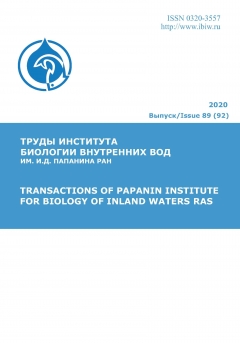Двигательная активность данио (Danio rerio) имеет ярко выраженный циркадный ритм. При постоянном освещении период двигательной активности, контролируемый эндогенными осцилляторами, у этого вида обычно становится менее 24 часов. Чтобы оценить возможность увлечения циркадных ритмов медленными магнитными флуктуациями, оценивали двигательную активность данио при постоянном освещении в магнитном поле, медленно флуктуирующем с периодом 26.8 ч. Периодограмма Ломба-Скаргла выявила значимые ритмы двигательной активности и связанных с ней поведенческих показателей с периодом около 27 ч. Полученные результаты указывают на возможность увлечения циркадных ритмов данио медленными магнитными колебаниями. Обсуждаются предполагаемые механизмы, ответственные за такое увлечение, включая возможную роль криптохромов.
магнитное поле, Danio rerio, криптохром, циркадный ритм, скорость плавания
1. Abhilash L., Sheeba V. RhythmicAlly: your R and Shiny-based open-source ally for the analysis of biological rhythms // J Biol Rhythms. 2019. Vol. 34(5). P. 551-561. https://doi.org/10.1177/0748730419862474.
2. Agliassa C., Maffei M.E. Reduction of geomagnetic field (GMF) to near null magnetic field (NNMF) affects some Arabidopsis thaliana clock genes amplitude in a light independent manner // J Plant Physiol. 2019. Vol. 232). P. 23-26. https://doi.org/10.1016/j.jplph.2018.11.008.
3. Audira G., Sampurna B.P., Juniardi S., Liang S.T., Lai Y.H., Han L., Hsiao C.D. Establishing simple image-based methods and a cost-effective instrument for toxicity assessment on circadian rhythm dysregulation in fish // Biol Open. 2019. Vol. 8:bio041871. https://doi.org/10.1242/bio.041871.
4. Bartos P., Netusil R., Slaby P., Dolezel D., Ritz T., Vacha M. Weak radiofrequency fields affect the insect circadian clock // J R Soc Interface. 2019. Vol. 16:20190285. https://doi.org/10.1098/rsif.2019.0285.
5. Bell-Pedersen D., Cassone V.M., Earnest D.J., Golden S.S., Hardin P.E., Thomas T.L., Zoran M.J. Circadian rhythms from multiple oscillators: lessons from diverse organisms // Nature reviews Genetics. 2005. Vol. 6(7). P. 544-556. https://doi.org/10.1038/nrg1633.
6. Bliss V.L., Heppner F.H. Circadian activity rhythm influenced by near zero magnetic field // Nature. 1976. Vol. 261(5559). P. 411-412. https://doi.org/10.1038/261411a0.
7. Brown F.A. Biological clocks: endogenous cycles synchronized by subtle geophysical rhythms // Biosystems. 1976. Vol. 8. P. 67-81. https://doi.org/10.1016/0303-2647(76)90010-1.
8. Brown F.A., Scow K.M. Magnetic induction of a circadian cycle in hamsters // J Interdiscipl Cycle Res. 1978. Vol. 9. P. 137-145. https://doi.org/10.1080/09291017809359632.
9. Burton C.E., Zhou Y., Bai Q., Burton E.A. Spectral properties of the zebrafish visual motor response // Neurosci Lett. 2017. Vol. 646. P. 62-67. https://doi.org/10.1016/j.neulet.2017.03.002.
10. Cahill G.M. Circadian regulation of melatonin production in cultured zebrafish pineal and retina // Brain Res. 1996. Vol. 708(1-2). P. 177-181. https://doi.org/10.1016/0006-8993(95)01365-2.
11. Cermakian N., Whitmore D., Foulkes N.S., Sassone-Corsi P. Asynchronous oscillations of two zebrafish CLOCK partners reveal differential clock control and function // PNAS. 2000. Vol. 97(8). P. 4339-4344. https://doi.org/10.1073/pnas.97.8.4339.
12. Chiou Y.Y., Yang Y., Rashid N., Ye R., Selby C.P., Sancar A. Mammalian Period represses and de-represses transcription by displacing CLOCK-BMAL1 from promoters in a Cryptochrome-dependent manner // PNAS. 2016. Vol. 113(41). P. E6072-E6079. https://doi.org/10.1073/pnas.1612917113.
13. Cornelissen G. Cosinor-based rhythmometry // Theor Biol Med Model. 2014. 11:16. https://doi.org/10.1186/1742-4682-11-16.
14. Cresci A., De Rosa R., Fraissinet S., Scanu M., Putman N.F., Agnisola C. Zebrafish “personality” influences sensitivity to magnetic fields // Acta Ethol. 2018. Vol. 21. pp. 195-201. https://doi.org/10.1007/s10211-018-0292-9.
15. del Pozo A., Sánchez-Férez J.A., Sánchez-Vázquez F.J. Circadian rhythms of self-feeding and locomotor activity in zebrafish (Danio rerio) // Chronobiol Int. 2011. Vol. 28(1). P. 39-47. https://doi.org/10.3109/07420528.2010.530728.
16. Demin K.A., Lakstygal A.M., Alekseeva P.A., Sysoev M., de Abreu M.S., Alpyshov E.T., Serikuly N., Wang D., Wang M., Tang Z., Yan D., Strekalova T.V., Volgin A.D., Amstislavskaya T.G., Wang J., Song C., Kalueff A.V. The role of intraspecies variation in fish neurobehavioral and neuropharmacological phenotypes in aquatic models // Aquat Toxicol. 2019. Vol. 210. pp. 44-55. https://doi.org/10.1016/j.aquatox.2019.02.015.
17. Dibner C., Schibler U., Albrecht U. The mammalian circadian timing system: organization and coordination of central and peripheral clocks // Annu Rev Physiol. 2010. Vol. 72. P. 517-549. https://doi.org/10.1146/annurev-physiol-021909-135821.
18. Finger A.M., Dibner C., Kramer A. Coupled network of the circadian clocks: a driving force of rhythmic physiology // FEBS Lett. 2020. Vol. 594. P. 2734-2769. https://doi.org/10.1002/1873-3468.13898.
19. Frøland Steindal I.A., Whitmore D. Circadian clocks in fish - what have we learned so far? // Biology. 2019. Vol. 8:17. https://doi.org/10.3390/biology8010017.
20. Hore P.J., Mouritsen H. The radical-pair mechanism of magnetoreception // Annu Rev Biophys. 2016. Vol. 45. P. 299-344. https://doi.org/10.1146/annurev-biophys-032116-094545.
21. Hurd M.W., Debruyne J., Straume M., Cahill G.M. Circadian rhythms of locomotor activity in zebrafish // Physiol Behav. 1998. Vol. 65. P. 465-472. https://doi.org/10.1016/S0031-9384(98)00183-8.
22. Idda M.L., Bertolucci C., Vallone D., Gothilf Y., Sánchez-Vázquez F.J., Foulkes N.S. Circadian clocks: lessons from fish // Prog Brain Res. 2012. Vol. 199. P. 41-57. https://doi.org/10.1016/B978-0-444-59427-3.00003-4.
23. Khan Z.A., Yumnamcha T., Rajiv C., Sanjita Devi H., Mondal G., Devi S.D., Bharali R., Chattoraj A. Melatonin biosynthesizing enzyme genes and clock genes in ovary and whole brain of zebrafish (Danio rerio): Differential expression and a possible interplay // Gen Comp Endocrinol. 2016. Vol. 233. P. 16-31. https://doi.org/10.1016/j.ygcen.2016.05.014.
24. Krylov V.V. Biological effects related to geomagnetic activity and possible mechanisms // Bioelectromagnetics. 2017. Vol. 38. P. 497-510. https://doi.org/10.1002/bem.22062.
25. Krylov V.V., Izvekov E.I., Pavlova V.V., Pankova N.A., Osipova E.A. Circadian rhythms in zebrafish (Danio rerio) behaviour and the sources of their variability // Biol Rev. 2021. Vol. 96(3). P. 785-797. https://doi.org/10.1111/brv.12678.
26. Krylov V.V., Kantserova N.P., Lysenko L.A., Osipova E.A. A simulated geomagnetic storm unsynchronizes with diurnal geomagnetic variation affecting calpain activity in roach and great pond snail // Int J Biometeorol. 2019. Vol. 63(2). P. 241-246. https://doi.org/10.1007/s00484-018-01657-y.
27. Krylov V.V., Osipova E.A., Pankova N.A., Talikina M.G., Chebotareva Yu.V., Izyumov Yu.G., Batrakova A.A., Nepomnyashchikh V.A. The effect of a temporal shift in diurnal geomagnetic variation on roach Rutilus rutilus L. embryos: a comparison with effects of simulated geomagnetic storms // Biophysics. 2017. Vol. 62. P. 675-681. https://doi.org/10.1134/S0006350917040121.
28. Krylov V.V., Papchenkova G.A., Osipova E.A. The influence of changes in magnetic variations and light−dark cycle on life-history traits of Daphnia magna // Bioelectromagnetics. 2020. Vol. 41(5). P. 338-347. https://doi.org/10.1002/bem.22264.
29. Krylov V.V., Zotov O.D., Klain B.I., Ushakova N.V., Kantserova N.P., Znobisheva A.V., Izyumov Yu.G., Kuz’mina V.V., Morozov A.A., Lysenko L.A., Nemova N.N., Osipova E.A. An experimental study of the biological effects of geomagnetic disturbances: the impact of a typical geomagnetic storm and its constituents on plants and animals // J. Atmos. Sol-Terr. Phys. 2014. Vol. 110-111. P. 28-36. https://doi.org/10.1016/j.jastp.2014.01.020.
30. LeGates T., Fernandez D., Hattar S. Light as a central modulator of circadian rhythms, sleep and affect // Nat Rev Neurosci. 2014. Vol. 15. P. 443-454. https://doi.org/10.1038/nrn3743.
31. Lima-Cabello E., Diaz-Casado M.E., Guerrero J.A., Otalora B.B., Escames G., Lopez L.C., Reiter R.J., Acuna-Castroviejo D. A review of the melatonin functions in zebrafish physiology // J Pineal Res. 2014. Vol. 57. P. 1-9. https://doi.org/10.1111/jpi.12149.
32. López-Olmeda J.F., Madrid J.A., Sánchez-Vázquez F.J. Light and temperature cycles as zeitgebers of zebrafish (Danio rerio) circadian activity rhythms // Chronobiol Int. 2006. Vol. 23(3). P. 537-550. https://doi.org/10.1080/07420520600651065.
33. López-Olmeda J.F., Tartaglione E.V., de la Iglesia H.O., Sánchez-Vázquez F.J. Feeding entrainment of food-anticipatory activity and per1 expression in the brain and liver of zebrafish under different lighting and feeding conditions // Chronobiol Int. 2010. Vol. 27. P. 1380-1400. https://doi.org/10.3109/07420528.2010.501926.
34. Malhotra N., Chen J.R., Sarasamma S., Audira G., Siregar P., Liang S.T., Lai Y.H., Lin G.M., Ger T.R., Hsiao C.D. Ecotoxicity assessment of Fe3O4 magnetic nanoparticle exposure in adult zebrafish at an environmental pertinent concentration by behavioral and biochemical testing // Nanomaterials. 2019. Vol. 9:e873. https://doi.org/10.3390/nano9060873.
35. Mendoza-Viveros L., Bouchard-Cannon P., Hegazi S., Cheng A.H., Pastore S., Cheng H.Y.M. Molecular modulators of the circadian clock: lessons from flies and mice // Cell Mo. Life Sci. 2017. Vol. 74. P. 1035-1059. https://doi.org/10.1007/s00018-016-2378-8.
36. Noldus L.P., Spink A.J., Tegelenbosch R.A. EthoVision: a versatile video tracking system for automation of behavioral experiments // Behav Res Methods Instrum Comput. 2001. Vol. 33. P. 398-414. https://doi.org/10.3758/bf03195394.
37. Osipova E.A., Pavlova V.V., Nepomnyashchikh V.A., Krylov V.V. Influence of magnetic field on zebrafish activity and orientation in a plus maze // Behav Processes. 2016. Vol. 122. P. 80-86. https://doi.org/10.1016/j.beproc.2015.11.009.
38. Patke A., Young M.W., Axelrod S. Molecular mechanisms and physiological importance of circadian rhythms // Nat Rev Mol Cell Biol. 2020. Vol. 21. P. 67-84. https://doi.org/10.1038/s41580-019-0179-2.
39. Pérez-Escudero A., Vicente-Page J., Hinz R.C., Arganda S., de Polavieja G.G. idTracker: tracking individuals in a group by automatic identification of unmarked animals // Nat Methods. 2014. Vol. 11. P. 743-748. https://doi.org/10.1038/nmeth.2994.
40. Sarasamma S., Audira G., Juniardi S., Sampurna B.P., Lai Y.H., Hao E., Chen J.R., Hsiao C.D. Evaluation of the effects of carbon 60 nanoparticle exposure to adult zebrafish: a behavioral and biochemical approach to elucidate the mechanism of toxicity // Int J Mol Sci. 2018. Vol. 19:e3853. https://doi.org/10.3390/ijms19123853.
41. Shenk J., Lohkamp K.J., Wiesmann M., Kiliaan A.J. Automated analysis of stroke mouse trajectory data with Traja // Front Neurosci. 2020. Vol. 14:518. https://doi.org/10.3389/fnins.2020.00518.
42. Solov’yov I.A., Chandler D.E., Schulten K. Magnetic field effects in Arabidopsis thaliana cryptochrome-1 // Biophys J. 2007. Vol. 92. P. 2711-2726. https://doi.org/10.1529/biophysj.106.097139.
43. Tackenberg M.C., Hughey J.J. The risks of using the chi-square periodogram to estimate the period of biological rhythms // PLoS Comput Biol. 2021. Vol. 17(1):e1008567. https://doi.org/10.1371/journal.pcbi.1008567.
44. Wager-Smith K., Kay S.A. Circadian rhythm genetics: from flies to mice to humans // Nat Genet. 2000. Vol. 26. P. 23-27. https://doi.org/10.1038/79134.
45. Wan G.J., Wang W.J., Xu J.J., Yang Q.F., Dai M.J., Zhang F.J., Sword G.A., Pan W.D., Chen F.J. Cryptochromes and hormone signal transduction under near-zero magnetic fields: new clues to magnetic field effects in a rice planthopper // PLoS ONE. 2015. Vol. 10(7):e0132966. https://doi.org/10.1371/journal.pone.0132966.
46. Welker H.A., Semm P., Willig R.P., Commentz J.C., Wiltschko W., Vollrath L. Effects of an artificial magnetic-field on serotonin-n-acetyltransferase activity and melatonin content of the rat pineal gland // Exp Brain Res. 1983. Vol. 50. P. 426-432. https://doi.org/10.1007/BF00239209.
47. Whitmore D., Foulkes N., Strähle U., Sassone-Corsi P. Zebrafish clock rhythmic expression reveals independent peripheral circadian oscillators // Nat Neurosci. 1998. Vol. 1. P. 701-707. https://doi.org/10.1038/3703.
48. Yamazaki Y., Maute A. Sq and EEJ - a review on the daily variation of the geomagnetic field caused by ionospheric dynamo currents // Space Sci Rev. 2017. Vol. 206. P. 299-405. https://doi.org/10.1007/s11214-016-0282-z.








